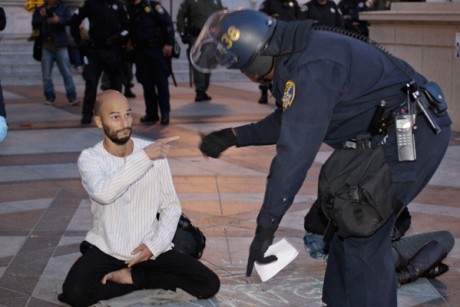My debut piece at the Huffington Post I recently took a pilgrimage to Corpus Christi Church on 121st Street off of Broadway, here in New York City. This is where Thomas Merton, the great Catholic monk/mystic/author, was baptized, formally beginning a spiritual journey which has captivated and inspired millions of truth-seekers over the past few generations, myself included.
It was a special enough moment to be there, but a certain deeper resonance came as I stepped back out into the street, as I suddenly saw my past, present and future all before me. My past, raised in the Catholic tradition by my family in Detroit, as represented by Corpus Christi Church and Merton, faced me in my present situation, as an aspiring Hindu minister in New York City. I turned to my left to see the potentiality of my future, as represented by Union Theological Seminary, where I am currently applying, and where I hope to find an experience to harmonize my spiritual aspirations with my concern to be a servant to create justice in the world.
I was reminded that we owe a tremendous debt to that which has shaped us, to those who have helped to form us. We can forget this so easily, when the cult of our own individuality oversteps its boundaries. I was once again reminded that what I appreciate most of all in my own spiritual journey is gaining a greater and more loving acceptance of where I have come from, from the sacred roots of my family.
The Catholic faith of my youth planted within me the seeds to seek the truth. Now the tables have turned, as my experience of the incredible vistas of Hindu theology and practice has turned a shining light back to where I was before. In fact, I see that where I was before is very much the same as I am now. My Hindu faith has made me a better Christian.
Even as a child, the stories and wisdom I received in church and in catechism spoke to me of a profound yet simple reality: God is a person who knows and loves me dearly and deeply, and that I am also a person who can return that love in a very personal and unique way.
As I began to study the great Bhagavad-Gita, I found out that my seemingly childish impression of a personal and loving God was not actually so. It was steeped in the deepest truth. The theology of the Gita is immense and all-inclusive. The reality of the Divine is explained in three ways: God is His all-pervasive, transpersonal essence, the guide or conscience within our heart, and also a distinct individual. It is His unique personal feature which the Gita describes as being the preeminent of these three aspects.
The Gita climaxes with this passage, in which Krishna, the original Personality of God as described in Hinduism, tells his friend Arjuna that:
Always think of Me, become My devotee, worship Me and offer your homage unto Me. Thus you will come to Me without fail. I promise you this because you are My very dear friend.
I remember hearing, as a child, that God was always with me, seeing what I was doing, understanding my heart. There was never a moment where I felt threatened by this. Instead, I simply felt like I had a dear friend who would always be with me, and who would always help me, and whom I felt I could love in return. As I entered into the Bhakti faith I began to experience this simple reality in all its depth.
The path of Bhakti which I follow is a system of connection, or yoga, with God, based on the idea of loving, devotional service. Real devotional service is the giving of one's body, mind, and words to the service of God. In the Bhakti-rasamrta-sindhu, a classical 16th century devotional treatise, we read that:
"When first-class devotional service develops, one must be devoid of all material desires, knowledge obtained by monistic philosophy, and fruitive action. The devotee must constantly serve Kṛṣṇa favorably, as Kṛṣṇa desires."
The Hindu diaspora is filled with examples of such fidelity, including A.C Bhaktivedanta Swami Prabhupada, who braved the rigors of old age to bring the Bhakti tradition to the West at the age of 70 in 1965. In my exploration of my Christian roots, I come across the same mood in St. Francis of Assisi, who understood very deeply that to truly serve means to be an instrument of God. St. Francis wrote that:
O Divine Master, grant that I may not so much seek
to be consoled as to console,
to be understood as to understand,
to be loved, as to love. For it is in giving that we receive
It is in St. Francis's particular example that I understand that Bhakti is not exclusive to any one path or faith. Bhakti means devotion, love, surrender to the will of God. My own understanding of it as a practicing Hindu helps me to see its reality as the foundation of my Christian heritage as well.
As I pray and meditate and call God's names, it takes me into the memory of the examples before me, of my great-aunt chanting the rosary with daily and deep devotion in the living room of my childhood home, and of my grandfather taking to the Detroit airwaves in his youth to say the rosary as well.
These connections, sacred and sustaining to me, is where I really feel I have become a better Christian through my Hindu practice. It has allowed me to honor a desire in my family to carry forward a torch of devotion to God that transcends any cultural boundaries or differences.
Without the grace and knowledge I have received in my practice and life as a Hindu minister, I would not be able to approach my heritage as a Christian in such a meaningful way. This reality leaves me with a grateful heart, and a desire to go deeper into this harmony, to honor where I have come from, where I am now, and where I am meant to go.


















